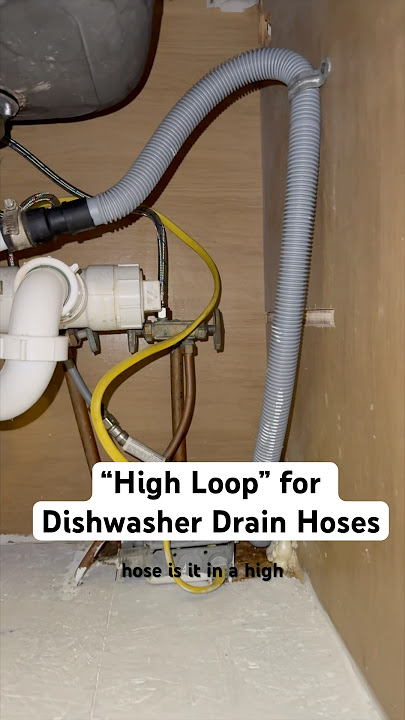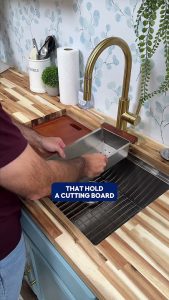Is your kitchen sink backing up when you run the dishwasher? A clogged or leaking dishwasher drain can turn your daily routine into a frustrating mess.
But don’t worry—you don’t need to call a plumber just yet. You’ll learn simple, step-by-step ways to fix your kitchen sink with a dishwasher drain issue. By the end, you’ll have the confidence to tackle the problem yourself and keep your kitchen running smoothly.
Keep reading—you’re closer to a hassle-free sink than you think!

Credit: www.youtube.com
Common Dishwasher Drain Issues
Dishwasher drains can be tricky. Even a small issue can cause water to back up or leak, disrupting your kitchen routine. Understanding common problems helps you spot and fix them before they turn into costly repairs.
Clogs And Blockages
Food particles, grease, and soap scum often build up inside the dishwasher drain hose or garbage disposal. This buildup slows down drainage, causing water to pool in your sink or dishwasher. You might notice water backing up or a foul smell.
Try using a mixture of hot water and vinegar to break down minor clogs. If that doesn’t work, disconnect the hose and check for blockages manually. Have you ever found unexpected debris lodged in your dishwasher drain?
Leaking Connections
Loose or damaged hose clamps and connections can cause leaks under your sink. Even a small drip wastes water and can damage cabinets over time. Check the hose where it connects to the sink drain and dishwasher for any cracks or loose fittings.
Replacing old clamps or tightening screws often solves the problem. Keep a towel handy when inspecting these areas—water might still be trapped inside the pipes. Do you regularly check your plumbing connections for wear and tear?
Backflow Problems
Backflow happens when dirty water from the sink drains back into the dishwasher. This usually occurs if the drain hose isn’t installed with a proper high loop or air gap. It can cause dirty water to pool inside your dishwasher, leading to poor cleaning and odors.
Make sure the drain hose loops above the sink’s flood level or install an air gap device. These simple fixes prevent water from flowing backward. Have you noticed dirty water sitting in your dishwasher after draining?

Credit: www.youtube.com
Tools And Materials Needed
Fixing a kitchen sink with a dishwasher drain requires the right tools and materials. Having everything ready makes the job easier and faster. Prepare well to avoid interruptions during the repair process.
Basic Plumbing Tools
- Adjustable wrench for tightening and loosening nuts
- Pipe wrench for gripping and turning pipes
- Slip-joint pliers for gripping small objects and fittings
- Bucket to catch water when disconnecting pipes
- Plumber’s tape to seal threaded pipe joints
- Utility knife for cutting hoses or tape
- Screwdrivers (flathead and Phillips) for removing clamps and screws
Replacement Parts
- Dishwasher drain hose if the old one is cracked or clogged
- Sink drain assembly parts such as gaskets and washers
- Hose clamps to secure the dishwasher drain hose
- P-trap replacement if the current trap is damaged or leaking
- Pipe connectors or adapters to fit different pipe sizes
Safety Gear
- Rubber gloves to protect hands from dirt and sharp edges
- Safety goggles to guard eyes from splashes and debris
- Old towels or rags to clean up spills quickly
- Face mask if working with dusty or moldy areas
Preparing For The Repair
Before you dive into fixing your kitchen sink with a dishwasher drain, it’s crucial to prepare properly. Taking these initial steps can save you time, prevent damage, and keep you safe throughout the repair process. Skipping preparation often leads to frustrating setbacks that could have been easily avoided.
Turn Off Water Supply
Start by locating the water shutoff valve under your sink or near your home’s main water line. Turning off the water supply stops leaks and flooding while you work on the pipes. Have a bucket or towel handy just in case some water drips when you disconnect the drain.
Disconnect Power To Dishwasher
Safety is key, so make sure you disconnect your dishwasher from its power source. Unplug the unit or switch off the breaker that controls the dishwasher’s circuit. This step prevents electrical accidents while handling the drain connections.
Clear The Area
Remove everything stored under the sink and around the dishwasher. A clear workspace helps you move freely and avoids damage to your belongings. Plus, it gives you better access to pipes and connections, making the repair smoother and faster.
Fixing A Clogged Drain
Fixing a clogged drain in a kitchen sink with a dishwasher drain can feel like a daunting task. But with the right approach, you can clear the blockage yourself without calling a plumber. Let’s walk through practical steps that tackle common causes of clogs effectively.
Remove Visible Debris
Start by checking the sink drain and the dishwasher drain connection for any visible debris. Food scraps, grease buildup, or small objects can easily block the flow of water. Use gloves and a flashlight to carefully remove any gunk you see, making sure not to push it further down the drain.
Have you ever been surprised by how much stuff gets stuck just at the surface? Clearing this first makes the next steps much easier and often solves the problem quickly.
Use A Plunger Or Drain Snake
If the clog isn’t visible or removing debris didn’t help, try using a plunger designed for sinks. Seal the sink drain properly and pump the plunger several times to create pressure that can dislodge the clog. Don’t forget to block the dishwasher drain opening while plunging to direct the force where it’s needed.
When plunging doesn’t work, a drain snake is your next best tool. Insert the snake into the drain and twist it to catch or break up the clog. You’ll be surprised how often this simple tool can clear stubborn blockages.
Apply Baking Soda And Vinegar
Baking soda and vinegar create a natural fizzing reaction that helps break down grime inside your pipes. Pour about half a cup of baking soda into the drain, followed by half a cup of vinegar. Cover the drain with a plug to keep the reaction concentrated, and wait 15-30 minutes before flushing with hot water.
This method is gentle on your pipes and safe for the environment. Have you noticed how often household ingredients can solve problems without harsh chemicals? Give it a try before reaching for commercial drain cleaners.
Repairing Leaks In Drain Connections
Leaks in your kitchen sink’s dishwasher drain connections can cause water damage and reduce the efficiency of your plumbing. Fixing these leaks promptly helps prevent mold growth and unpleasant odors. The key is to carefully inspect and address common trouble spots like hose clamps, damaged hoses, and loose joints.
Check Hose Clamps
Hose clamps hold the drain hose tightly in place, preventing leaks where the hose connects to the sink or dishwasher. Over time, these clamps can loosen or rust, leading to water escaping at the connection points.
Start by visually inspecting each clamp for signs of corrosion or looseness. Use a screwdriver to gently tighten any loose clamps. If a clamp looks worn out or damaged, replacing it with a new stainless steel clamp can stop the leak quickly.
Replace Damaged Hoses
Your dishwasher’s drain hose is flexible but can crack, crack, or develop holes after years of use. Even a small puncture allows water to drip under the sink, which often goes unnoticed until damage appears.
Examine the entire length of the hose for cracks, bulges, or soft spots. If you find any damage, replace the hose with a new one of the same diameter and length. This simple swap can save you from ongoing leaks and costly repairs down the line.
Seal Joints With Plumber’s Tape
Joints where hoses connect to fittings need a tight seal to keep water inside the pipes. Plumber’s tape (also called Teflon tape) creates a waterproof barrier that prevents leaks at threaded connections.
Wrap the tape clockwise around the threads before reattaching the hose or fitting. Two or three layers are usually enough to create a strong seal. After sealing, check for leaks by running water through the dishwasher drain and watching carefully.
Preventing Drain Backflow
Preventing drain backflow is essential to keep your kitchen sink and dishwasher running smoothly. Backflow happens when wastewater flows in the wrong direction, causing dirty water to enter your dishwasher or sink. This can lead to clogs, bad odors, and even health hazards.
Understanding how to stop backflow will save you time and frustration. Have you ever noticed water pooling around your sink after running the dishwasher? That’s often a sign of backflow issues you can fix with the right techniques.
Install A Check Valve
A check valve acts like a one-way gate for water, allowing it to flow out but not back in. Installing one on your dishwasher drain line prevents wastewater from returning to your dishwasher or sink.
Check valves are inexpensive and easy to install. You just need to cut the drain hose, insert the valve in the right direction, and secure it tightly. This small addition can stop a lot of headaches caused by backflow.
Adjust Dishwasher Drain Hose Height
The height of your dishwasher drain hose plays a big role in preventing backflow. The hose should be looped up higher than the sink drain connection to create a natural barrier for wastewater.
A good rule is to position the hose at least 20 inches above the floor or countertop. This setup uses gravity to keep dirty water from flowing back into your dishwasher, making your drainage system more reliable.
Secure Air Gap Fittings
Air gap fittings are designed to prevent dirty water from siphoning back into your dishwasher. They work by introducing air into the drain line, breaking any potential backflow path.
Make sure the air gap is installed correctly and kept free from blockages. If you don’t have an air gap, consider adding one—it’s a simple fix that improves your kitchen’s hygiene and functionality.
Testing The Repair
Testing the Repair Ensure water drains smoothly from the sink to the dishwasher. Check for leaks under the sink. Listen for unusual sounds during operation, indicating potential issues.
Once you’ve completed the repair on your kitchen sink with a dishwasher drain, it’s crucial to ensure everything is functioning perfectly. Testing the repair is essential to catch any potential issues early on. This will save you from future headaches and potential water damage. Ready to see the results of your hard work? Let’s dive into the testing process.
Run Dishwasher Cycle
Start by running a full dishwasher cycle. This allows you to observe the system under typical conditions. It also ensures that the dishwasher is draining properly into the sink without any obstruction. You might feel a little anxious during this part, especially if you’ve had previous issues. But don’t worry—watching the cycle closely will give you peace of mind.
Inspect For Leaks
While the dishwasher is running, check under the sink for any leaks. Feel around the pipes and the junctions for any moisture. A small trickle might seem insignificant, but it could lead to bigger problems later. Use a flashlight to inspect hard-to-see areas. This ensures no hidden leaks escape your notice.
Check Drain Flow
Once the dishwasher completes its cycle, observe the water flow through the drain. It should be smooth and steady without any backups. If you notice water pooling or draining slowly, there might be an issue with the connections or the drain itself. You may need to adjust the pipes or ensure they are not clogged. Testing your repair thoroughly helps you identify any lingering issues and ensures your kitchen sink and dishwasher work harmoniously. Are you ready to enjoy a smoothly functioning kitchen?

Credit: www.youtube.com
Maintenance Tips For Dishwasher Drains
Keeping your dishwasher drain in good condition prevents clogs and leaks. Regular maintenance saves time and costly repairs. Simple care routines help your kitchen sink and dishwasher work smoothly.
Regular Cleaning
Clean the dishwasher drain often to stop buildup. Use warm water and mild soap to remove grease. A soft brush helps clear away stuck food particles. Running the dishwasher empty with vinegar can also clean pipes inside.
Avoiding Food Debris
Remove large food scraps from dishes before loading the dishwasher. Avoid washing greasy pots and pans directly in the dishwasher. Use a sink strainer to catch debris that could block the drain. This keeps the drain clear and flowing well.
Routine Inspection
Check the dishwasher drain and hose regularly for leaks or damage. Look for cracks, loose connections, or unusual smells. Tighten any loose fittings with a wrench. Early detection prevents bigger problems later on.
Frequently Asked Questions
How Do I Fix A Dishwasher Drain In My Kitchen Sink?
To fix a dishwasher drain, first check for clogs in the drain hose. Tighten connections and clean the air gap. Replace damaged hoses or faulty clamps to ensure proper drainage.
Why Is My Kitchen Sink Draining Slowly With Dishwasher?
Slow drainage can be due to clogged pipes or a blocked dishwasher drain hose. Clear debris and clean the sink trap to improve flow. Regular maintenance prevents future slow draining issues.
Can A Dishwasher Drain Cause Sink Leaks?
Yes, a faulty dishwasher drain connection can cause leaks under the sink. Inspect hoses and seals for cracks or loose fittings. Replace damaged parts immediately to avoid water damage.
How Do I Prevent Dishwasher Drain Backups In The Sink?
Prevent backups by regularly cleaning the drain hose and garbage disposal. Avoid pouring grease or food scraps down the sink. Use strainers and run hot water during dishwasher cycles.
Conclusion
Fixing a kitchen sink with a dishwasher drain is easier than it seems. Follow each step carefully and stay patient. Check for leaks and test the drain after repair. Small problems can cause big issues if ignored. Taking time now saves future headaches and expenses.
Keep tools and parts ready before you start. This simple fix improves your kitchen’s function quickly. You can handle it with basic skills and some care. Don’t rush. Stay safe and enjoy your working sink again.




